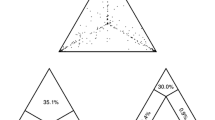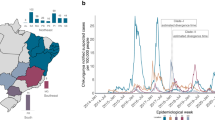Abstract
Recent outbreaks of Zika virus (ZIKV) infections in Oceania's islands and the Americas were characterized by high numbers of cases and the spread of the virus to new areas. To better understand the origin of ZIKV, its epidemic history was reviewed. Although the available records and information are limited, two major genetic lineages of ZIKV were identified in previous studies. However, in this study, three lineages were identified based on a phylogenetic analysis of all virus sequences from GenBank, including those of the envelope protein (E) and non-structural protein 5 (NS5) coding regions. The spatial and temporal distributions of the three identified ZIKV lineages and the recombination events and mechanisms underlying their divergence and evolution were further elaborated. The potential migration pathway of ZIKV was also characterized. Our findings revealed the central roles of two African countries, Senegal and Cote d'Ivoire, in ZIKV evolution and genotypic divergence. Furthermore, our results suggested that the outbreaks in Asia and the Pacific islands originated from Africa. The results provide insights into the geographic origins of ZIKV outbreaks and the spread of the virus, and also contribute to a better understanding of ZIKV evolution, which is important for the prevention and control of ZIKV infections.

Similar content being viewed by others
References
Alera MT, Hermann L, Tac-An IA, Klungthong C, Rutvisuttinunt W, Manasatienkij W, Villa D, Thaisomboonsuk B, Velasco JM, Chinnawirotpisan P, Lago CB, Roque VG, Jr., Macareo LR, Srikiatkhachorn A, Fernandez S, Yoon IK. 2015. Zika virus infection, Philippines, 2012. Emerg Infect Dis, 21: 722–724.
Asahina S. 1970. Transoceanic flight of mosquitoes on the Northwest Pacific. Jpn J Med Sci Biol, 23: 255–258.
Baronti C, Piorkowski G, Charrel RN, Boubis L, Leparc-Goffart I, de Lamballerie X. 2014. Complete coding sequence of zika virus from a French polynesia outbreak in 2013. Genome Announc, 2.
Berthet N, Nakoune E, Kamgang B, Selekon B, Descorps-Declere S, Gessain A, Manuguerra JC, Kazanji M. 2014. Molecular Characterization of Three Zika Flaviviruses Obtained from Sylvatic Mosquitoes in the Central African Republic. Vector Borne Zoonotic Dis, 14: 862–865.
Buathong R, Hermann L, Thaisomboonsuk B, Rutvisuttinunt W, Klungthong C, Chinnawirotpisan P, Manasatienkij W, Nisalak A, Fernandez S, Yoon IK, Akrasewi P, Plipat T. 2015. Detection of Zika Virus Infection in Thailand, 2012–2014. Am J Trop Med Hyg, 93: 380–383.
Cao-Lormeau VM, Roche C, Teissier A, Robin E, Berry AL, Mallet HP, Sall AA, Musso D. 2014. Zika virus, French polynesia, South pacific, 2013. Emerg Infect Dis, 20: 1085–1086.
Darwish MA, Hoogstraal H, Roberts TJ, Ahmed IP, Omar F. 1983. A Sero-Epidemiological Survey for Certain Arboviruses (Togaviridae) in Pakistan. Trans R Soc Trop Med Hyg, 77: 442–445.
Dick GW, Kitchen SF, Haddow AJ. 1952. Zika virus. I. Isolations and serological specificity. Trans R Soc Trop Med Hyg, 46: 509–520.
Duffy MR, Chen TH, Hancock WT, Powers AM, Kool JL, Lanciotti RS, Pretrick M, Marfel M, Holzbauer S, Dubray C, Guillaumot L, Griggs A, Bel M, Lambert AJ, Laven J, Kosoy O, Panella A, Biggerstaff BJ, Fischer M, Hayes EB. 2009. Zika virus outbreak on Yap Island, Federated States of Micronesia. N Engl J Med, 360: 2536–2543.
Dupont-Rouzeyrol M, O'Connor O, Calvez E, Daures M, John M, Grangeon JP, Gourinat AC. 2015. Co-infection with Zika and dengue viruses in 2 patients, New Caledonia, 2014. Emerg Infect Dis, 21: 381–382.
Enfissi A, Codrington J, Roosblad J, Kazanji M, Rousset D. 2016a. Zika virus genome from the Americas. Lancet, 387: 227–228.
Enfissi A, Codrington J, Roosblad J, Kazanji M, Rousset D. 2016b. Zika virus genome from the Americas. Lancet, 387: 227–228.
Enserink M. 2015. INFECTIOUS DISEASES. An obscure mosquito-borne disease goes global. Science, 350: 1012–1013.
Faye O, Freire CC, Iamarino A, Faye O, de Oliveira JV, Diallo M, Zanotto PM, Sall AA. 2014. Molecular evolution of Zika virus during its emergence in the 20(th) century. PLoS Negl Trop Dis, 8: e2636.
Filipe AR, Martins CM, Rocha H. 1973. Laboratory infection with Zika virus after vaccination against yellow fever. Arch Gesamte Virusforsch, 43: 315–319.
Fonseca K, Meatherall B, Zarra D, Drebot M, MacDonald J, Pabbaraju K, Wong S, Webster P, Lindsay R, Tellier R. 2014. First case of Zika virus infection in a returning Canadian traveler. Am J Trop Med Hyg, 91: 1035–1038.
Foy BD, Kobylinski KC, Chilson Foy JL, Blitvich BJ, Travassos da Rosa A, Haddow AD, Lanciotti RS, Tesh RB. 2011. Probable non-vector-borne transmission of Zika virus, Colorado, USA. Emerg Infect Dis, 17: 880–882.
Grard G, Caron M, Mombo IM, Nkoghe D, Mboui Ondo S, Jiolle D, Fontenille D, Paupy C, Leroy EM. 2014. Zika virus in Gabon (Central Africa)—2007: a new threat from Aedes albopictus? PLoS Negl Trop Dis, 8: e2681.
Haddow AD, Schuh AJ, Yasuda CY, Kasper MR, Heang V, Huy R, Guzman H, Tesh RB, Weaver SC. 2012. Genetic characterization of Zika virus strains: geographic expansion of the Asian lineage. PLoS Negl Trop Dis, 6: e1477.
Hancock WT, Marfel M, Bel M. 2014. Zika virus, French Polynesia, South Pacific, 2013. Emerg Infect Dis, 20: 1960.
Hayes EB. 2009. Zika virus outside Africa. Emerg Infect Dis, 15: 1347–1350.
Heang V, Yasuda CY, Sovann L, Haddow AD, Travassos da Rosa AP, Tesh RB, Kasper MR. 2012. Zika virus infection, Cambodia, 2010. Emerg Infect Dis, 18: 349–351.
Jan C, Languillat G, Renaudet J, Robin Y. 1978. A serological survey of arboviruses in Gabon. Bull Soc Pathol Exot Filiales, 71: 140–146. (In French)
Kindhauser MK, Allen T, Frank V, Santhana RS, Dye C. 2016. Zika: the origin and spread of a mosquito-borne virus. Bull World Health Organ.
Lanciotti RS, Kosoy OL, Laven JJ, Velez JO, Lambert AJ, Johnson AJ, Stanfield SM, Duffy MR. 2008. Genetic and serologic properties of Zika virus associated with an epidemic, Yap State, Micronesia, 2007. Emerg Infect Dis, 14: 1232–1239.
Leung GH, Baird RW, Druce J, Anstey NM. 2015. Zika Virus Infection in Australia Following a Monkey Bite in Indonesia. Southeast Asian J Trop Med Public Health, 46: 460–464.
Macnamara FN. 1954. Zika virus: a report on three cases of human infection during an epidemic of jaundice in Nigeria. Trans R Soc Trop Med Hyg, 48: 139–145.
Marchette NJ, Garcia R, Rudnick A. 1969. Isolation of Zika virus from Aedes aegypti mosquitoes in Malaysia. Am J Trop Med Hyg, 18: 411–415.
Martin DP, Lemey P, Lott M, Moulton V, Posada D, Lefeuvre P. 2010. RDP3: a flexible and fast computer program for analyzing recombination. Bioinformatics, 26: 2462–2463.
Mlakar J, Korva M, Tul N, Popovic M, Poljsak-Prijatelj M, Mraz J, Kolenc M, Resman Rus K, Vesnaver Vipotnik T, Fabjan Vodusek V, Vizjak A, Pizem J, Petrovec M, Avsic Zupanc T. 2016. Zika Virus Associated with Microcephaly. N Engl J Med. 374: 951–958.
Moore DL, Causey OR, Carey DE, Reddy S, Cooke AR, Akinkugbe FM, David-West TS, Kemp GE. 1975. Arthropodborne viral infections of man in Nigeria, 1964–1970. Ann Trop Med Parasitol, 69: 49–64.
Musso D, Cao-Lormeau VM, Gubler DJ. 2015. Zika virus: following the path of dengue and chikungunya? Lancet, 386: 243–244.
Oehler E, Watrin L, Larre P, Leparc-Goffart I, Lastere S, Valour F, Baudouin L, Mallet H, Musso D, Ghawche F. 2014. Zika virus infection complicated by Guillain-Barre syndrome—case report, French Polynesia, December 2013. Euro Surveill, 19.
Olson JG, Ksiazek TG, Gubler DJ, Lubis SI, Simanjuntak G, Lee VH, Nalim S, Juslis K, See R. 1983. A survey for arboviral antibodies in sera of humans and animals in Lombok, Republic of Indonesia. Ann Trop Med Parasitol, 77: 131–137.
Olson JG, Ksiazek TG, Suhandiman, Triwibowo. 1981. Zika virus, a cause of fever in Central Java, Indonesia. Trans R Soc Trop Med Hyg, 75: 389–393.
Pond WL. 1963. Arthropod-Borne Virus Antibodies in Sera from Residents of South-East Asia. Trans R Soc Trop Med Hyg, 57: 364–371.
Roth A, Mercier A, Lepers C, Hoy D, Duituturaga S, Benyon E, Guillaumot L, Souares Y. 2014. Concurrent outbreaks of dengue, chikungunya and Zika virus infections -an unprecedented epidemic wave of mosquito-borne viruses in the Pacific 2012–2014. Euro Surveill, 19.
Saluzzo JF, Gonzalez JP, Herve JP, Georges AJ. 1981. [Serological survey for the prevalence of certain arboviruses in the human population of the south-east area of Central African Republic]. Bull Soc Pathol Exot Filiales,} 74}: 490–4
Simpson DI. 1964. Zika Virus Infection in Man. Trans R Soc Trop Med Hyg, 58: 335–338.
Smithburn KC. 1952. Neutralizing antibodies against certain recently isolated viruses in the sera of human beings residing in East Africa. J Immunol, 69: 223–234.
Smithburn KC, Taylor RM, Rizk F, Kader A. 1954. Immunity to Certain Arthropod-Borne Viruses among Indigenous Residents of Egypt. Am J Trop Med Hyg, 3: 9–18.
Tappe D, Nachtigall S, Kapaun A, Schnitzler P, Gunther S, Schmidt-Chanasit J. 2015. Acute Zika Virus Infection after Travel to Malaysian Borneo, September 2014. Emerg Infect Dis, 21: 911–913.
Tognarelli J, Ulloa S, Villagra E, Lagos J, Aguayo C, Fasce R, Parra B, Mora J, Becerra N, Lagos N, Vera L, Olivares B, Vilches M, Fernandez J. 2015 A report on the outbreak of Zika virus on Easter Island, South Pacific, 2014. Arch Virol. 161: 665–668.
Urdaneta-Marquez L, Failloux AB. 2011. Population genetic structure of Aedes aegypti, the principal vector of dengue viruses. Infect Genet Evol, 11: 253–261.
Waehre T, Maagard A, Tappe D, Cadar D, Schmidt-Chanasit J. 2014. Zika virus infection after travel to Tahiti, December 2013. Emerg Infect Dis, 20: 1412–1414.
Waggoner JJ, Pinsky BA. 2016. Zika Virus: Diagnostics for an Emerging Pandemic Threat. J Clin Microbiol, 54: 860–867.
Wallace RG, Hodac H, Lathrop RH, Fitch WM. 2007. A statistical phylogeography of influenza A H5N1. Proc Natl Acad Sci U S A, 104: 4473–4478.
Weaver SC, Lecuit M. 2015. Chikungunya virus and the global spread of a mosquito-borne disease. N Engl J Med, 372: 1231–1239.
World Health Organization. 2014. A global brief on vector-borne diseases.
Zammarchi L, Stella G, Mantella A, Bartolozzi D, Tappe D, Gunther S, Oestereich L, Cadar D, Munoz-Fontela C, Bartoloni A, Schmidt-Chanasit J. 2015. Zika virus infections imported to Italy: clinical, immunological and virological findings, and public health implications. J Clin Virol, 63: 32–35.
Author information
Authors and Affiliations
Corresponding author
Additional information
ORCID: 0000-0002-5385-083X
Electronic supplementary material
Rights and permissions
About this article
Cite this article
Shen, S., Shi, J., Wang, J. et al. Phylogenetic analysis revealed the central roles of two African countries in the evolution and worldwide spread of Zika virus. Virol. Sin. 31, 118–130 (2016). https://doi.org/10.1007/s12250-016-3774-9
Received:
Accepted:
Published:
Issue Date:
DOI: https://doi.org/10.1007/s12250-016-3774-9




